CIMA F3 Financial Strategy Exam Practice Test
Financial Strategy Questions and Answers
Company M is a listed company in a highly technical service industry.
The directors are considering making a cash offer for the shares in Company Q, an unquoted company in the same industry.
Relevant data about Company Q:
• The company has seen consistent growth in earnings each year since it was founded 10 years ago.
• It has relatively few non-current assets.
• Many of the employees are leading experts in their field. A recent exercise suggested that the value of the company's human capital exceeded the value of its tangible assets.
The directors and major shareholders of Company Q have indicated willingness to sell the company.
Before negotiations become too advanced, the directors of Company M are considering the benefits to their company that would follow the acquisition.
Which THREE of the following are the most likely benefits of the acquisition to Company M's shareholders?
A company is concerned about the interest rate that it will be required to pay on a planned bond issue.
It is considering issuing bonds with warrants attached.
Advise the directors which of the following statements about warrants is NOT correct?
Company C is a listed company. It is currently considering the acquisition of Company D. The original founder of Company C currently owns 52% of the shares.
Alternative forms of consideration for Company D being considered are as follows:
• Cash payment, financed by new borrowing
• issue of new shares in Company C
Which of the following is an advantage of a cash offer over a share-for exchange from the viewpoint of the original founder of Company C?
Providers of debt finance often insist on covenants being entered into when providing debt finance for companies.
Agreement and adherence to the specific covenants is often a condition of the loan provided by the lender.
Which THREE of the following statements are true in respect of covenants?
Company AEE has a 10 year 6% corporate bond in issue which has a nominal value of $400 million, which is currently trading at 95%. The bond is secured on the company's property
The Board of Directors has calculated the equity value of Company AEE as follows;

Which THREE of the following are errors in the valuation?
Company A is planning to acquire Company B. Both companies are listed and are of similar size based on market capitalisation No approach has yet been made to Company B's shareholders as the directors of Company A are undecided about the most suitable method of financing the offer Two methods are under consideration a share exchange or a cash offer financed by debt.
Company A currently has a gearing ratio (debt to debt plus equity) of 30% based on market values. The average gearing ratio (debt to debt plus equity) for the industry is 50% Although no formal offer has been made there have been market rumours of the proposed bid. which is seen as favorable to Company A. As a consequence. Company As share price has risen over the past few weeks while Company B's share price has fallen.
Which THREE of the following statements are most likely to be correct?
Holding cash in excess of business requirements rather than returning the cash to shareholders is most likely to result in lower:
An unlisted company is attempting to value its equity using the dividend valuation model.
Relevant information is as follows:
• A dividend of $500,000 has just been paid.
• Dividend growth of 8% is expected for the foreseeable future.
• Earnings growth of 6% is expected for the foreseeable future.
• The cost of equity of a proxy listed company is 15%.
• The risk premium required due to the company being unlisted is 3%.
The calculation that has been performed is as follows:
Equity value = $540,000 / (0.18 - 0.08) = $5,400,000
What is the fault with the calculation that has been performed?
Which THREE of the following would be of most interest to lenders deciding whether to provide long-term debt to a company?
A company is wholly equity funded. It has the following relevant data:
• Dividend just paid $4 million
• Dividend growth rate is constant at 5%
• The risk free rate is 4%
• The market premium is 7%
• The company's equity beta factor is 1.2
Calculate the value of the company using the Dividend Growth Model.
Give your answer in $ million to 2 decimal places.
$ ? million
Company J is in negotiations to acquire Company K and believes it can turn around Company K's performance to match its own.
The following information is available for the two companies:
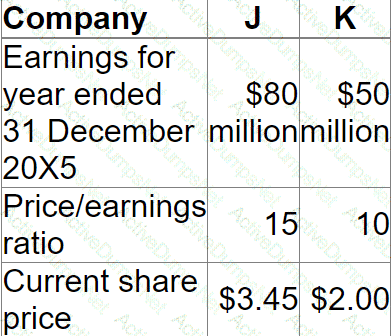
Select the maximum price for each share that Company J should place on Company K during negotiations.
Which THREE of the following methods of business valuation would give a valuation of the equity of an entity, rather than the value of the whole entity?
A is a listed company. Its shares trade on a stock market exhibiting semi-strong form efficiency.
Which of the following is most likely to increase the wealth of A's shareholders?
For which THREE of the following risk categories does IFRS 7 require sensitivity analysis?
Which THREE of the following are benefits of integrated reporting?
Company Z wishes to borrow $50 million for 10 years at a fixed rate of interest.
Two alternative approaches are being considered:
A. Issue a 10 year bond at a fixed rate of 6%, or
B. Borrow from the bank at Libor +2.5% for a 10 year period and simultaneously enter into a 10 year interest rate swap.
Current 10 year swap rates against Libor are 4.0% - 4.2%.
What is the difference in the net interest cost between the two alternative approaches?
B, a European based modern art dealer, frequently imports and sells single high value items created in the United States. The price is fixed at the date of sale but the items are commissioned and made to order with a lead time of three to nine months depending on the individual specification
B holds payment for his customers from the point of purchase and passes funds when the items are shipped However, despite putting the money on short term deposit, there have been times when B's profits have been almost entirely eroded by adverse movements m interest rates Advise B by matching the appropriate instrument to B's requirements.
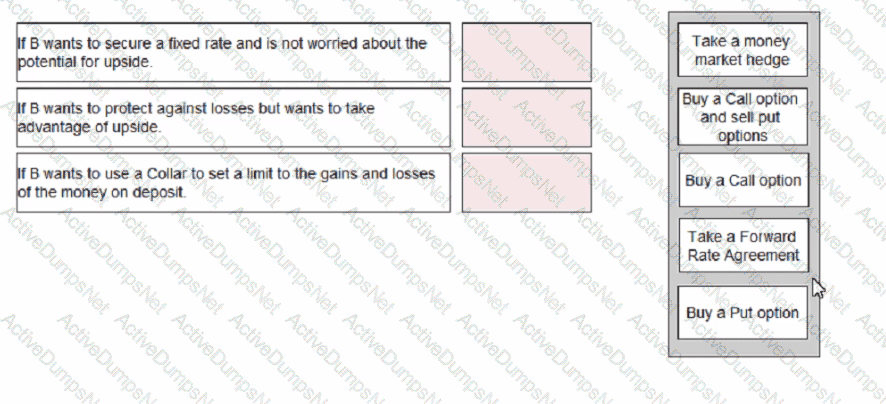
Two companies that operate in the same industry have different Price/Earnings (P/E) ratios as follows:
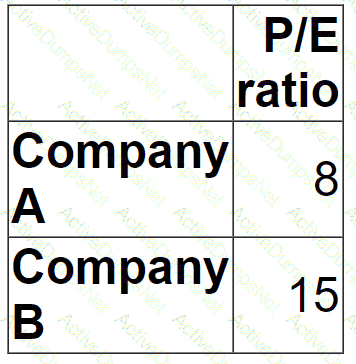
Which of the following is the most likely explanation of the different P/E ratios?
A profit-seeking company intends to acquire another company for a variety of reasons, primarily to enhance shareholder wealth.
Which THREE of the following offer the greatest potential for enhancing shareholder wealth?
Company Z has identified four potential acquisition targets: companies A, B. C and D.
Company Z has a current equity market value of S590 million.
The price it would have to pay for the equity of each company is as follows:

Only one of the target companies can be acquired and the consideration will be paid in cash.
The following estimations of the new combined value of Company Z have been prepared for each acquisition before deduction of the cash consideration:

Ignoring any premium paid on acquisition, which acquisition should the directors pursue?
Company A, a listed company, plans to acquire Company T, which is also listed.
Additional information is:
• Company A has 150 million shares in issue, with market price currently at $7.00 per share.
• Company T has 120 million shares in issue,. with market price currently at $6.00 each share.
• Synergies valued at $50 million are expected to arise from the acquisition.
• The terms of the offer will be 2 shares in A for 3 shares in T.
Assuming the offer is accepted and the synergies are realised, what should the post-acquisition price of each of Company A's shares be?
Give your answer to two decimal places.

Three companies are quoted on the New York Stock Exchange. The following data applies:

Which of the following statements is TRUE?
An analyst has valued a company using the free cash flow valuation model.
The analyst used the following data in determining the value:
• Estimated free cashflow in 1 year's time = $100,000
• Estimated growth in free cashflow after the first year = 5% each year indefinitely
• Appropriate cost of equity = 10%
The result produced by the analyst was as follows:
Value of equity = $100,000 (1+0.05)/0.10 = $1,050,000
The analyst made a number of errors in determining the value.
By how much has the analyst undervalued the company?
A company intends to sell one of its business units. Company W, by a management buyout (MBO). A selling price of S200 million has been agreed.
The managers are discussing with a bank and a venture capital company (VCC) the following financing proposal.
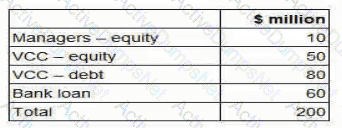
The VCC requires a minimum return on its equity investment In the MBO of 35% a year on a compound basis over 5 years. What is the minimum total equity value of Company W in 5 years time in order to meet the VCC's required return? Give your answer to one decimal place.

M is an accountant who wishes to take out a forward rate agreement as a hedging instrument but the company treasurer has advised that a short-term interest rate future would be a better option.
Which of the following is true of a short-term interest rate future?
A financial services company reported the following results in its most recent accounting period:
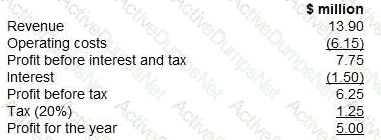
The company has an objective to achieve 5% earnings growth each year. The directors are discussing how this objective might be achieved next year.
Revenues have been flat over the last couple of years as the company has faced difficult trading conditions. Revenue is expected to stay constant in the coming year and so the directors are focussing efforts on reducing costs in an attempt to achieve earnings growth next year.
Interest costs will not change because the company's borrowings are subject to a fixed rate of interest.
What operating profit margin will the company have to achieve next year in order to just achieve its 5% earnings growth objective'?
RST wishes to raise at least $40 million of new equity by issuing up to 10 million new equity shares at a minimum price of $3.00 under an offer for sale by tender. It receives the following tender offers:

What is the maximum amount that RST can raise by this share issue?
(Give your answer to the nearest $ million).

A company enters into a floating rate borrowing with interest due every 12 months over the five year life of the borrowing.
At the same time, the company arranges an interest rate swap to swap the interest profile on the borrowing from floating to fixed rate.
These transactions are designated as a hedge for hedge accounting purposes under IAS 39 Financial Instruments: Recognition and Measurement.
Assuming the hedge is considered to be effective, how would the swap be accounted for 12 months later?
The Senior Management Team of ABC, an owner-managed, capital intensive start-up engineering business, is considering the options for its dividend policy. It has so far been a successful business and is expanding quickly Once in place, the Senior Management Team anticipates that its current investment plans will yield returns for many years to come The first agenda item at every meeting currently concerns arranging and funding new equipment and premises.
Which of the following dividend policies is likely to be the most suitable?
A government is currently considering the privatisation of the national airline. The shares are to be offered to the public via a fixed price Initial Public Offering (IPO).
Which THREE of the following statements are correct?
PPA owns $500,000 of shares in Company ABB. Company ABB has a daily volatility of 2% of its share price
Calculate the 12-day value at risk that shows the most PPA can expect to lose during a 12-day period (PPA wishes to be 90% certain that the actual loss in any month will be less than your predicted figure)
Give your answer to the nearest thousand dollars.

Which of the following is NOT an advantage of a share repurchase?
An all equity financed company plans an issue of new ordinary shares to the general public to raise finance for a new project
The following data applies:
• 10 million ordinary shares are currently in issue with a market value of S3 each share
• The new project will cost S2.88 million and is expected to give a positive NPV of S1 million
• The issue will be priced at a AaA discount to the current share price.
What gam or loss per share will accrue to the existing shareholders?
PYP is a listed courier company. It is looking to raise new finance to fit each of its delivery vans with new equipment to allow improved parcel tracking for customers The senior management team of PYP have decided on a 10-year secured bond to finance this investment-
Which TWO of the following variables are most likely to decrease the yield to maturity of the bond?
A geared and profitable company is evaluating the best method of financing the purchase of new machinery. It is considering either buying the machinery outright, financed by a secured bank borrowing and selling the machinery at the end of a fixed period of time or obtain the machinery under a lease for the same period of time.
Which is the correct discount rate to use when discounting the incremental cash flows of the lease against those of the buy and borrow alternative?
A listed company has suffered a period of falling revenues and profit margins. It has been obliged to issue a profit warning to the market and its share price has fallen sharply. The company relies heavily on debt finance and is discussing with its banks possible refinancing options to assist with a restructuring programme.
Which THREE of the following are likely to be of MOST interest to the company's banks when they review the refinancing requests?
Company X plans to acquire Company Y.
Pre-acquisition information:
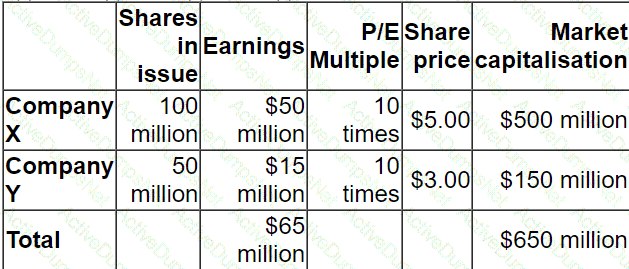
Post-acquisition information:
Total combined earnings are expected to increase by 10%
Total combined P/E multiple will remain at 10 times
Which of the following share-for-share exchanges will result in an increase of 10% in Company X's share price post-acquisition?
Company WWW is considering making a takeover bid for Company KKA Company KKA's current share price is $5.00
Company WWW is considering either
" A cash payment of $5.75 for each share in Company KKA
" A 5 year corporate bond with a market value of $90 in exchange for 15 shares in Company KKA
Calculate the highest percentage premium which Company KKA shareholders will receive.
Which THREE of the following statements are true of a money market hedge?
A national rail operating company has made an offer to acquire a smaller competitor.
Which of the following pieces of information would be of most concern to the competition authorities?
Company W is a manufacturing company with three divisions, all of which are making profits:
• Division A which manufactures cars
• Division B which manufactures trucks
• Division C which manufactures agricultural machinery
Company W is facing severe competitive pressure in all of its markets, and is currently operating with a high level of gearing Company W's latest forecasts suggest that it needs to raise cash to avoid breaching loan covenants on its existing debt finance in 6 months' time
In a recent strategy review. Divisions A and B were identified as being the core divisions of Company W
The management of Division C is known to be interested in the possibility of a management buy-out. Company Z is known to be interested in making a takeover bid for Company W's truck manufacturing division
A rival to Company W has recently successfully demerged its business, this was well received by the Financial markets
Which of the following exit strategies will be most suitable for company W?
Select whether the following statements are true or false with regard to Modigliani and Miller's dividend policy theory.

Which of the following would be a reason for a company to adopt a low dividend pay-out policy?
The shares of a company in a high technology industry have been listed on a stock exchange for 10 years. During this period, it has paid no dividends but invested all retained earnings in growth. The company is now entering a period of relatively stable growth and the directors are considering beginning to pay dividends They are reviewing the following suggestions made by members of the board:
• Pay cash dividends linked to growth in earnings
• Use a residual theory approach to establish cash dividends
• Issue scrip dividends (shares instead of cash)
• Continue to pay no dividends as dividends are irrelevant to the value of the company
Which THREE of the following are correct statements for the directors to take into consideration when making a decision about future dividend policy?
A company raised fixed rate bank finance together with an interest rate swap for the same term and same principal value to pay floating receive fixed rate interest on an annual basis.
Which THREE of the following statements are correct?
A company's Board of Directors is assessing the likely impact of financing future new projects using either equity or debt.
The directors are uncertain of the effects on key variables.
Which THREE of the following statements are true?
The Treasurer of Z intends to use interest rate options to set an interest rate cap on Z’s borrowings.
Which of the following statement is correct?
A company needs to raise $20 million to finance a project.
It has decided on a rights issue at a discount of 20% to its current market share price.
There are currently 20 million shares in issue with a nominal value of $1 and a market price of $5 per share.
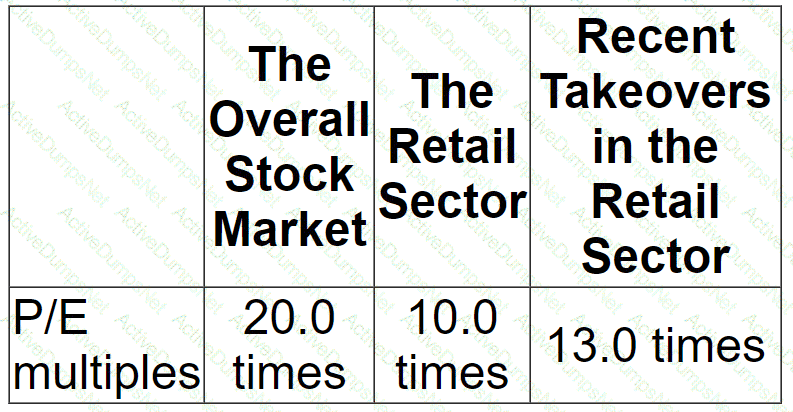
Calculate the terms of the rights issue.
A company currently has a 6.25% fixed rate loan but it wishes to change the interest style of the loan to variable by using an interest rate swap directly with the bank.
The bank has quoted the following swap rate:
• 5.50% - 5.55% in exchange for LIBOR
LIBOR is currently 5%.
If the company enters into the swap and LIBOR remains at 5%, what will the company's interest cost be?
If a company's bonds are currently yielding 8% in the marketplace, why would the entity's cost of debt be lower than this?
Which THREE of the following statements about stock market listings are correct?
Company C has received an unwelcome takeover bid from Company P.
Company P is approximately twice the size of Company C based on market capitalisation.
Although the two companies have some common business interests, the main aim of the bid is diversification for Company P.
The offer from Company P is a share exchange of 2 shares in Company P for 3 shares in Company C.
There is a cash alternative of $5.50 for each Company C share.
Company C has substantial cash balances which the directors were planning to use to fund an acquisition.
These plans have not been announced to the market.
The following share price information is relevant. All prices are in $.
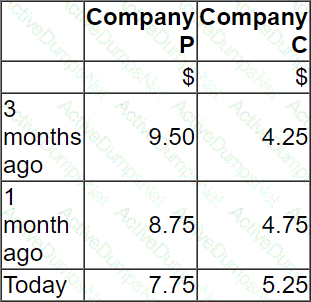
Which of the following would be the most appropriate action by Company C's directors following receipt of this hostile bid?
ZZZ wishes to borrow at a floating rate and has been told that it can use swaps to reduce the effective interest rate it pays. ZZZ can borrow floating at the risk-free rate + 1, and fixed at 10%.
Which of the following companies would be the most appropriate for ZZZ to enter into a swap with?
G pic wishes to borrow $5 million in 6 months, for a period of 3 months. A bank has quoted the following Forward Rate Agreement (FRA) rales:
3 v 9 6.55%-6.70% 6v9 6.70%-6 90%.
G pic can borrow at 0 75% above base rate, and the base rate is currently 6.25% Concerned that base rates may rise, G pic decides that it will hedge using an FRA
At the settlement date for the FRA, the base rate has risen to 7.50%
What is the effective interest rate paid by G pic for its borrowing?
A listed company has recently announced a profit warning.
The company's share price fell 20% on the day of the announcement but had been fairly static in the weeks leading up to the announcement.
Which form of efficient market is most likely to be indicated by this share price movement?
A venture capitalist invests in a company by means of buying:
• 9 million shares for $2 a share and
• 8% bonds with a nominal value of $2 million, repayable at par in 3 years' time.
The venture capitalist expects a return on the equity portion of the investment of at least 20% a year on a compound basis over the first 3 years of the investment.
The company has 10 million shares in issue.
What is the minimum total equity value for the company in 3 years' time required to satisify the venture capitalist's expected return?
Give your answer to the nearest $ million.
$ million.
A company's main objective is to achieve an average growth in dividends of 10% a year.
In the most recent financial year:
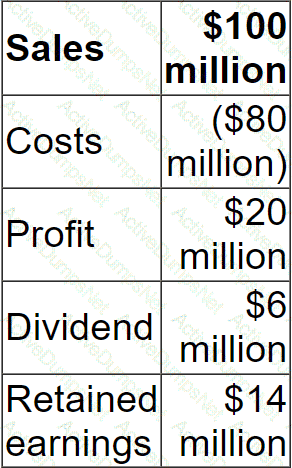
Sales are expected to grow at 8% a year over the next 5 years.
Costs are expected to grow at 5% a year over the next 5 years.
What is the minimum dividend payout ratio in 5 years' time that would allow the company to achieve its objective?
A company plans to raise S15 million to finance an expansion project using a rights issue Relevant data
• Shares will be offered at a 20% discount to the present market price of S12 50 per share
• There are currently 3 million shares in issue
• The project is forecast to yield a positive NPV of $9 million
What is the yield-adjusted Theoretical Ex-Rights Price following the announcement of the rights issue?
A company is deciding whether to offer a scrip dividend or a cash dividend to its shareholders.
Although the company has excellent long-term growth prospects, it is experiencing short-term profit and cash flow problems.
Which of the following statements is most likely to be a reason for choosing the scrip dividend?
KKL is a listed sports clothing company with three separate business units. KKL is seeking to sell TT’, one of these business units
TTP cwns a new. brand of trail running shoes that have Droved hugely popular with lone distance runners. The management team of TTP are frustrated by the constraints imposes b/ KKL in managing tie brand and developing. the bus ness and they believe that TTF has huge growth potential.
The management team of TTP have approached KKL with a proposal to purchase 1~P through a management layout (MDO). KKL has accepted this proposal as TTP has not proved to be a good fit' with the rest of the business and has agreed on the selling price.
Which THREE of the following factors a-e mast Likely to affect the success of the MBO?
A profitable company wishes to dispose of a loss-making division that generated negative free cashflow in the last financial year.
The division requires significant new investment to return it to profitability.
Which of the following valuation approaches is likely to be the most useful to the company when negotiating the sales price?
A Venture Capital Fund currently holds a significant shareholding in a large private company as a result of funding a recent management buyout. It plans to exit this investment in 5 years time at a significant profit.
Which THREE of the following exit mechanisms are most likely to be preferred by the Venture Capital Fund?
A listed company with a growing share price plans to finance a four-year research project with debt.
The main criterion for the finance is to minimise the annual cashflow payments on the debt.
The research will be sold at the end of the project.
Which of the following would be the most suitable financing method for the company?
Company A is based in Country A where the functional currency is the A$. Currently all sales are to domestic customers in Country A. However, the company is planning to expand internationally by acquiring Company B, a distribution company in Country B, to enable it to sell goods worldwide The functional currency of Country B is the BS
Company A will invoice its international customers in their local currency.
Wage increases in Country B are forecast to be modest, due to high unemployment levels, but overall inflation in Country B is forecast to be significantly higher than in Country A
Which TWO of the following statements about the economic risk of the acquisition of Company B are true?
Company A is unlisted and all-equity financed. It is trying to estimate its cost of equity.
The following information relates to another company, Company B, which operates in the same industry as Company A and has similar business risk:
Equity beta = 1.6
Debt:equity ratio 40:60
The rate of corporate income tax is 20%.
The expected premium on the market portfolio is 7% and the risk-free rate is 5%.
What is the estimated cost of equity for Company A?
Give your answer to one decimal place.
? %
Company Z has identified four potential acquisition targets: companies A, B, C and D.
Company Z has a current equity market value of $590 million.
The price it would have to pay for the equity of each company is as follows:

Only one of the target companies can be acquired and the consideration will be paid in cash.
The following estimations of the new combined value of Company Z have been prepared for each acquisition before deduction of the cash consideration:

Ignoring any premium paid on acquisition, which acquisition should the directors pursue?
Company ACC. an ungeared car manufacturer has launched a takeover bid of Company BDD. a key competitor operating in the same industry Company BDD has high gearing Company ACC has a large surplus cash balance and believes that the acquisition is an opportunity to enhance shareholder wealth through the realisation of synergistic benefits. Which THREE of the following would most likely be synergistic benefits to Company ACC of purchasing Company BDD9 I
A venture capitalist invests in a company by means of buying
* 6 million shares for $3 a share and
• 7% bonds with a nominal value of $2 million, repayable at par in 3 years' time
The venture capitalist expects a return on the equity portion of the investment of at least 20% a year on a compound basis over the first 3 years of the investment
The company has 8 million shares in issue
What is the minimum total equity value for the company in 3 years' time required to satisfy the venture capitalist's expected return?
Give your answer to the nearest $ million

A company has convertible bonds in issue.
The following debt is apply (31 December 20X0):
• Conversion ratio- 20 shares for each $130 bond.
• Current share price - $4 50
• Expected annual growth in share price - 5%
Advise the bond Holder at which date the convers on would be worthwhile?
A company is owned by its five directors who want to sell the business.
Current profit after tax is $750,000.
The directors are currently paid minimal salaries, taking most of their incomes as dividends.
After the company is sold, directors' salaries will need to be increased by $50,000 each year in total.
A suitable Price/Earnings (P/E) ratio is 7, and the rate of corporate tax is 20%.
What is the value of the company using a P/E valuation?
On 1 January:
• Company X has a value of $50 million
• Company Y has a value of $20 million
• Both companies are wholly equity financed
Company X plans to take over Company Y by means of a share exchange. Following the acquisition the post-tax cashflow of Company X for the foreseeable future is estimated to be $8 million each year. The post-acquisition cost of equity is expected to be 10%.
What is the best estimate of the value of the synergy that would arise from the acquisition?
Company AAB is located in Country A with the A$ as its functional currency It plans to grow by acquisition and has identified Company BBA as a potential takeover candidate Company BBA is located in Country B with the BS as its functional currency.
The directors of Company AAB are concerned about foreign currency risk if the acquisition goes ahead
Which of the following will be most effective in reducing Company AAB's exposure to translation risk if the acquisition is successful1?
A venture capitalist invests in a company by means of buying:
• 9 million shares for $2 a share and
• 8% bonds with a nominal value of $2 million, repayable at par in 3 years' time.
The venture capitalist expects a return on the equity portion of the investment of at least 20% a year on a compound basis over the first 3 years of the investment.
The company has 10 million shares in issue.
What is the minimum total equity value for the company in 3 years' time required to satisify the venture capitalist's expected return?
Give your answer to the nearest $ million.
$ million.
Company A is planning to acquire Company B at a price of $ 65 million by means of a cash bid.
Company A is confident that the merged entity can achieve the same price earnings ratio as that of Company A.
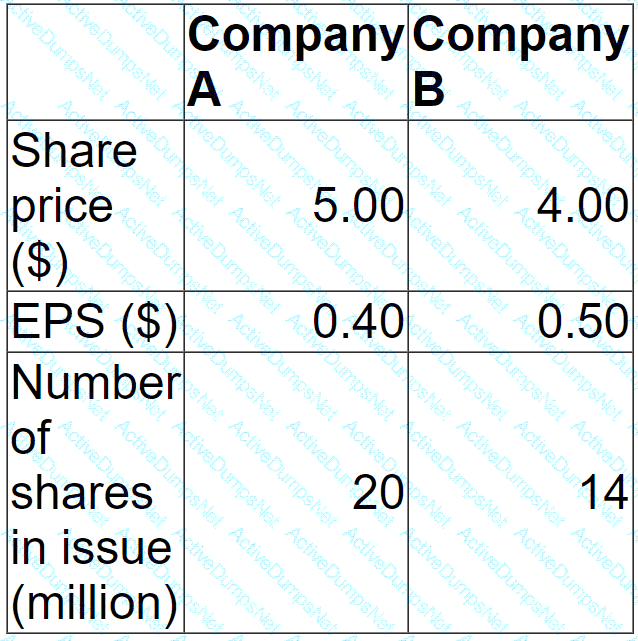
What does Company A expect the value of the merged entity to be post acquisition?
In the context of the Integrated Reporting
A venture capitalist is most likely to take which THREE of the following exit routes?
A company has accumulated a significant amount of excess cash which is not required for investment for the foreseeable future.
It is currently on deposit, earning negligible returns.
The Board of Directors is considering returning this excess cash to shareholders using a share repurchase programme.
The majority of shareholders are individuals with small shareholdings.
Which THREE of the following are advantages of the company undertaking a share repurchase programme?
The directors of a financial services company need to calculate a valuation of their company’s equity in preparation for an upcoming initial Public Offering (IPO) of shares. At a recent board meeting they discussed the various methods of business valuation.
The Chief Executive suggested using a Price-earing (P./E) method of valuation, but the finance Director argued that a valuation based on forecast cash flows to equity would be more appropriate.
Which THREE of the following are advantages of valuation based on forecast cash flows to equity, compared to a valuating using a price earnings methods?
Company A has just announced a takeover bid for Company B. The two companies are large companies in the same industry_ The bid is considered to be hostile.
Company B's Board of Directors intends to try to prevent the takeover as they do not consider it to be in the best interests of shareholders
Which THREE of the following are considered to be legitimate post-offer defences?
The ex div share price of Company A’s shares is $.3.50
An investor in Company A currently holds 2,000 shares.
Company A plans to issue a script divided of 1 new shares for every 10 shares currently held.
After the scrip divided, what will be the total wealth of the shareholder?
Give your answer to the nearest whole $.

Company U has made a bid for the entire share capital of Company B.
Company U is offering the shareholders in Company B the option of either a share exchange or a cash alternative.
Advise the shareholders in Company B which THREE of the following would be considered disadvantages of accepting the cash consideration?
Company BBB has prepared a valuation of a competitor company, Company BBD. Company BBB is intending to acquire a controlling interest in the equity of Company BBD and therefore wants to value only the equity of Company BBD.

The directors of Company BBB have prepared the following valuation of Company BBD:
Value of Equity = 4.63 + 5.14 + 5.56 = S15.33 million
Additional information on Company BBD:

Which THREE of the following are weaknesses of the above valuation?
PTT has a number of subsidiary companies around the world, including FTT based in Europe and CTT based in Indonesia
CTT purchases all of us raw materials from FTT CTT processes these materials and the resulting products are exported to several different countries CTT pays FTT in the Indonesian currency.
Indonesia's inflation is higher than that of FTTs home country
Which of the following statements are correct?
Select ALL that apply
A company is located in a single country. The company manufactures electrical goods for export and for sale in its home country. When exporting, it invoices in its customers' currency. What currency risks is the company exposed to?
WX, an advertising agency, has just completed the all-cash acquisition of a competitor, YZ. This was seen by the market as a positive strategic move byWX.
Which THREE of the following will WX's shareholders expect the company's directors to prioritise following the acquisition?
G purchased a put option that grants the right to cap the interest on a loan at 10.0%. Simultaneously, G sold a call option that grants the holder the benefits of any decrease if interest rates fall below 8.5%.
Which THREE possible explanations would be consistent with G's behavior?
The Board of Directors of Company T is considering a rights issue to fund a new investment opportunity which has a zero NPV.
The Board of Directors wishes to explain to shareholders what the theoretical impact on their wealth will be as a result of different possible actions during the rights issue.
Which THREE of the following statements in respect of theoretical shareholder wealth are true?
On 1 January:
• Company ABB has a value of $55 million
• Company BBA has a value of $25 million
• Both companies are wholly equity financed
Company ABB plans to take over Company BBA by means of a share exchange Following the acquisition the post-tax cashflow of Company ABB for the foreseeable future is estimated to be $10 million each year The post-acquisition cost of equity is expected to be 10%
What is the best estimate of the value of the synergy that would arise from the acquisition?
A company plans to raise $12 million to finance an expansion project using a rights issue.
Relevant data:
• Shares will be offered at a 20% discount to the present market price of $15.00 per share.
• There are currently 2 million shares in issue.
• The project is forecast to yield a positive NPV of $6 million.
What is the yield-adjusted Theoretical Ex-Rights Price following the announcement of the rights issue?
Which of the following statements about companies seeking a stock market listing is correct?
Company A is planning to acquire Company B by means of a cash offer. The directors of Company B are prepared to recommend acceptance if a bid price can be agreed. Estimates of the net present value (NPV) of future cash flows for the two companies and the combined group post acquisition have been prepared by Company A’s accountant. There are as follows:
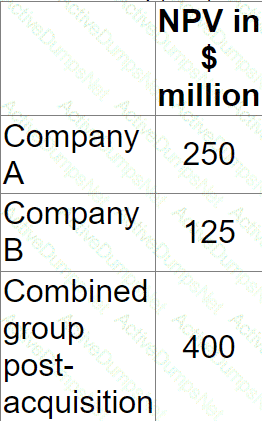
What is the maximum price that Company A should offer for the shares in Company B?
Give your answer to the nearest $ million

A listed company follows a policy of paying a constant dividend. The following information is available:
• Issued share capital (nominal value $0.50) $60 million
• Current market capitalisation $480 million
The shareholders are requesting an increased dividend this year as earnings have been growing. However, the directors wish to retain as much cash as possible to fund new investments. They therefore plan to announce a 1-for-10 scrip dividend to replace the usual cash dividend.
Assuming no other influence on share price, what is the expected share price following the scrip dividend?
Give your answer to 2 decimal places.
$ ?
Company A plans to acquire a minority stake in Company B.
The last available share price for Company B was $0.60.
Relevant data about Company B is as follows:
• A dividend per share of $0.08 has just been paid
• Dividend growth is expected to be 2%
• Earnings growth is expected to be 4%
• The cost of equity is 15%
• The weighted average cost of capital is 13%
Using the dividend growth model, what would be the expected change in share price?
Where a company acquires another company, which THREE of the following offer the greatest potential for enhancing shareholder wealth?
Which TIIRCC of the following are most likely to reduce the long term credit rating co a company?
A company has a 4% corporate bond in issue on which there are two loan covenants.
• Interest cover must not fall below 4 times
• Retained earnings for the year must not fall below S5 00 million
The Company has 100 million shares in issue. The most recent dividend per share was $0 10 The Company intends increasing dividends by 8% next year.
Financial projections tor next year are as follows:
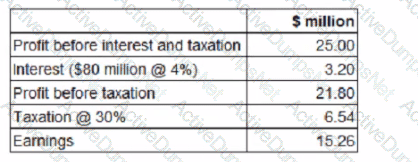
Advise the Board of Directors which of the following will be the status of compliance with the loan covenants next year?
A company financed by equity and debt can be valued by discounting:
Using the CAPM, the expected return for a company is 10%. The market return is 7% and the risk free rate is 1%.
What does the beta factor used in this calculation indicate about the risk of the company?
Formed in 2010, the International Integrated Reporting Council The primary purpose of the IIRC's framework is to help enable an organisation to communicate which of the following'?
Company A is subject to a takeover bid from Company B, both companies operate in the same industry and each of them demand a significant market share Company B h3S made an of an of $5 per share to the shareholders of Company A.
The directors of Company A do not believe the takeover would be in the best interests of the stakeholders and other stakeholders of Company A due to the following reruns
1. Company B has recently taken ever several ether companies resulting in them breaking up the company and se ling on the assets.
2 The directors of Company A believe the offer of $5 per snare undervalues tie company
The directors of Company A are therefore keen to prevent the bid from going ahead
Which THREE of the following defence strategies could be used by the directors of Company Air this situation?
A company has:
• A price/earnings (P/E) ratio of 10.
• Earnings of $10 million.
• A market equity value of $100 million.
The directors forecast that the company's P/E ratio will fall to 8 and earnings fall to $9 million.
Which of the following calculations gives the best estimate of new company equity value in $ million following such a change?
A)

B)

C)

D)

Option A
Option B
Option C
Option D
Company P is a large unlisted food-processing company.
Its current profit before interest and taxation is $4 million, which it expects to be maintainable in the future.
It has a $10 million long-term loan on which it pays interest of 10%.
Corporate tax is paid at the rate of 20%.
The following information on P/E multiples is available:
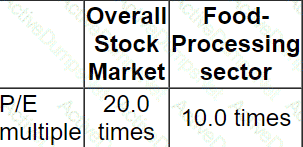
Which of the following is the best indication of the equity value of Company P?
Company YZZ has made a bid for the entire share capital of Company ZYY
Company YZZ is offering the shareholders in Company ZYY the option of either a share exchange or a cash alternative
Which THREE of the following would be considered disadvantages of accepting the cash consideration for the shareholders of Company ZYY?
Company A is a listed company that produces pottery goods which it sells throughout Europe. The pottery is then delivered to a network of self employed artists who are contracted to paint the pottery in their own homes. Finished goods are distributed by network of sales agents.The directors of Company A are now considering acquiring one or more smaller companies by means of vertical integration to improve profit margins.
Advise the Board of Company A which of the following acquisitions is most likely to achieve the stated aim of vertical integration?
A company in country T is considering either exporting its product directly to customers in country P or establishing a manufacturing subsidiary in country P.
The corporate tax rate in country T is 20% and 25% tax depreciation allowances are available
Which TIIRCC of the following would be considered advantages of establishing a subsidiary in country T?
At the last financial year end, 31 December 20X1, a company reported:
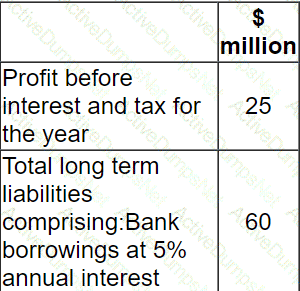
The corporate income tax rate is 30% and the bank borrowings are subject to an interest cover covenant of 4 times.
The results are presently comfortably within the interest cover covenant as they show interest cover of 8.3 times. The company plans to invest in a new product line which is not expected to affect profit in the first year but will require additional borrowings of $20 million at an annual interest rate of 10%.
What is the likely impact on the existing interest cover covenant?
A company has a loss-making division that it has decided to divest in order to raise cash for other parts of the business.
The losses stem from a combination of a lack of capital investment and poor divisional management.
The loss-making division would require new capital investment of at least $20 million in order to replace worn out and obsolete assets.
If this investment was carried out, the present value of the future cashflows, excluding the investment expenditure, is expected to be $15 million.
Which TWO of the following divestment methods are most likely to be suitable for the company?
ZZZ is a listed company based in Brinland. a European country. It is the largest owner and operator of residential care homes for elderly people in Brinland
Most of the residential care homes in Brinland are run by small private operators, and the standards of cafe are extremely variable However. 22Z has developed a good reputation because its client service is considered to be extremely good even though its prices are higher than those of most of its competitors.
ZZZ has expanded rapidly in the last few years, partly by acquisition and partly by organic growth consequently, the company's share price now stands at a record high, and the dividend declared at the end of the most recent accounting period was 10% higher than the previous year's dividend.
The Brinland government has recently set up a regulatory body to monitor the residential care homes industry. The regulatory body is considering introducing a variety of regulations to improve the customer experience in the industry. Following a period of consultation and investigation, the regulatory body is expected to announce a range of new regulations in the near future.
The directors of ZZZ are concerned that the new regulations may adversely affect their company
Which THREE of the following new regulations are likely to have the greatest negative impact on ZZTs performance?
An all equity financed company reported earnings for the year ending 31 December 20X1 of $5 million.
One of its financial objectives is to increase earnings by 5% each year.
In the year ending 31 December 20X2 it financed a project by issuing a bond with a $1 million nominal value and a coupon rate of 7%.
The company pays corporate income tax at 30%.
If the company is to achieve its earnings target for the year ending 31 December 20X2, what is the minimum operating profit (profit before interest and tax) that it must achieve?
A company has undertaken a transaction with its shareholders which has had the following impact on its financial statements:
• Retained earnings has decreased
• Share capital has increased
• Earnings per share has decreased
• The book value of equity is unchanged
The company has undertaken a:
A company has a cash surplus which it wishes to distribute to shareholders by a share repurchase rather than paying a special dividend.
Which THREE of the following statements are correct?
The Board of Directors of a listed company wish to estimate a reasonable valuation of the entire share capital of the company in the event of a takeover bid.
The company's current profit before taxation is $4.0 million.
The rate of corporate tax is 25%.
The average P/E multiple of listed companies in the same industry is 8 times current earnings.
The P/E multiple of recent takeovers in the same industry have ranged from 9 times to 10 times current earnings.
The average P/E multiple of the top 100 companies on the stock market is 15 times current earnings.
Advise the Board of Directors which of the following is a reasonable estimate of a range of values of the entire share capital in the event of a bid being made for the whole company?
Company M plans to bid for Company J. Company M has 20 million shares in issue and a current share price of $10.00 before publicly announcing the planned takeover. Company J has 10 million shares in issue and a current share price of $4.00.
The directors of Company M are considering an all-share bid of 1 Company M shares for 2 Company J shares.
Synergies worth $20m are expected from the acquisition.
What is the likely change in wealth for Company M's shareholders (in total) if the bid is accepted?
Give your answer to the nearest $ million.
$ ? million
A company's Board of Directors wishes to determine a range of values for its equity.
The following information is available:
Estimated net asset values (total asset less total liabilities including borrowings):
• Net book value = $20 million
• Net realisable value = $25 million
• Free cash flows to equity = $3.5 million each year indefinitely, post-tax.
• Cost of equity = 10%
• Weighted Average Cost of Capital = 7%
Advise the Board on reasonable minimum and maximum values for the equity.
A listed company in a high growth industry, where innovation is a key driver of success has always operated a residual dividend policy, resulting in volatility in dividends due to periodic significant investments in research and development.
The company has recently come under pressure from some investors to change its dividend policy so that shareholders receive a consistent growing dividend. In addition, they suggested that the company should use more debt finance.
If the suggested change is made to the financial policies, which THREE of the following statements are true?
A company is reporting under IFRS 7 Financial Instruments: Disclosures for the first time and the directors are concerned about whether this will lead to the disclosure of information that could affect the company's share price.
The company is based in a country that uses the A$ but 40% of revenue relates to export sales to the USA and priced in US$.
When the company reports under IFRS 7 for the first time, the share price is most likely to:
Company X is based in Country A, whose currency is the A$.
It trades with customers in Country B, whose currency is the B$.
Company X aims to maintain its revenue from exports to Country B at 25% of total revenue.
Company A has the following forecast revenue:
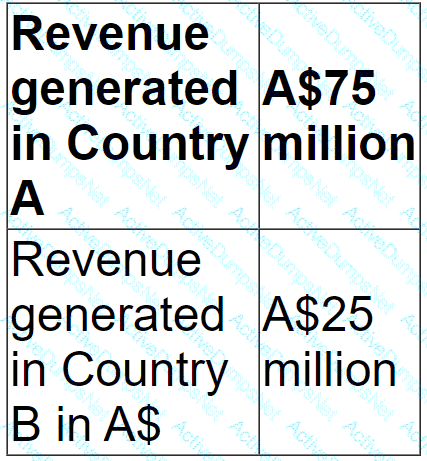
The forecast revenue from Country B has assumed an exchange rate of A$1/B$2, that is A$1 = B$2.
If the B$ depreciates against the A$ by 10%, the ratio of revenue generated from Country B as a percentage of total revenue will:


